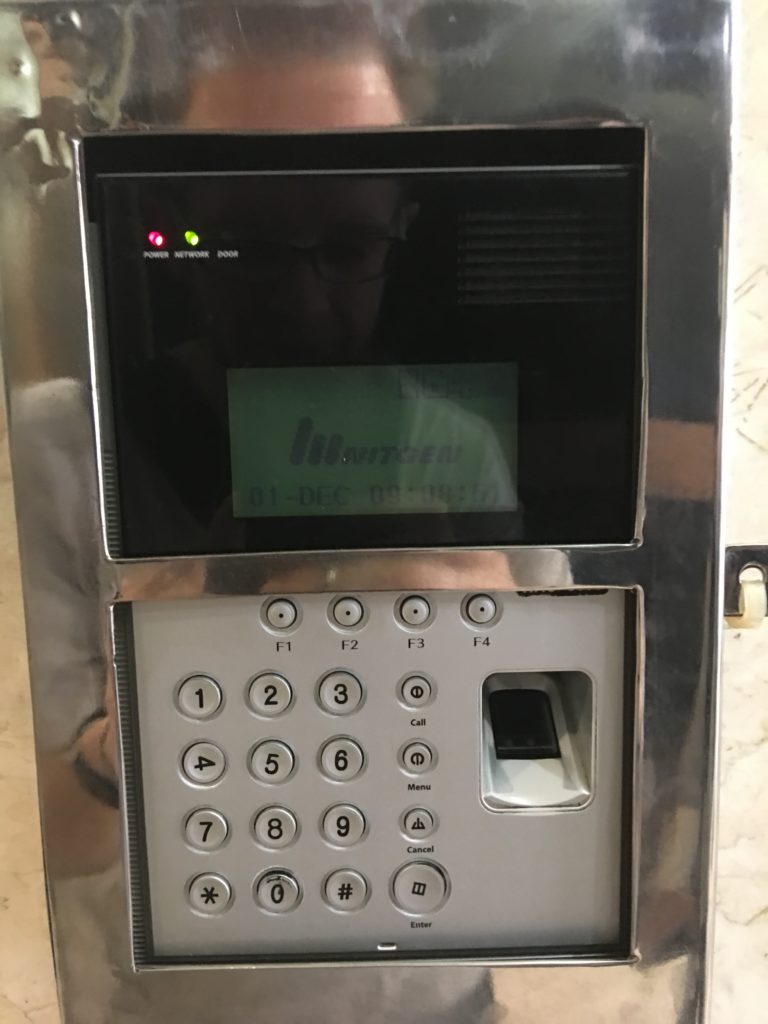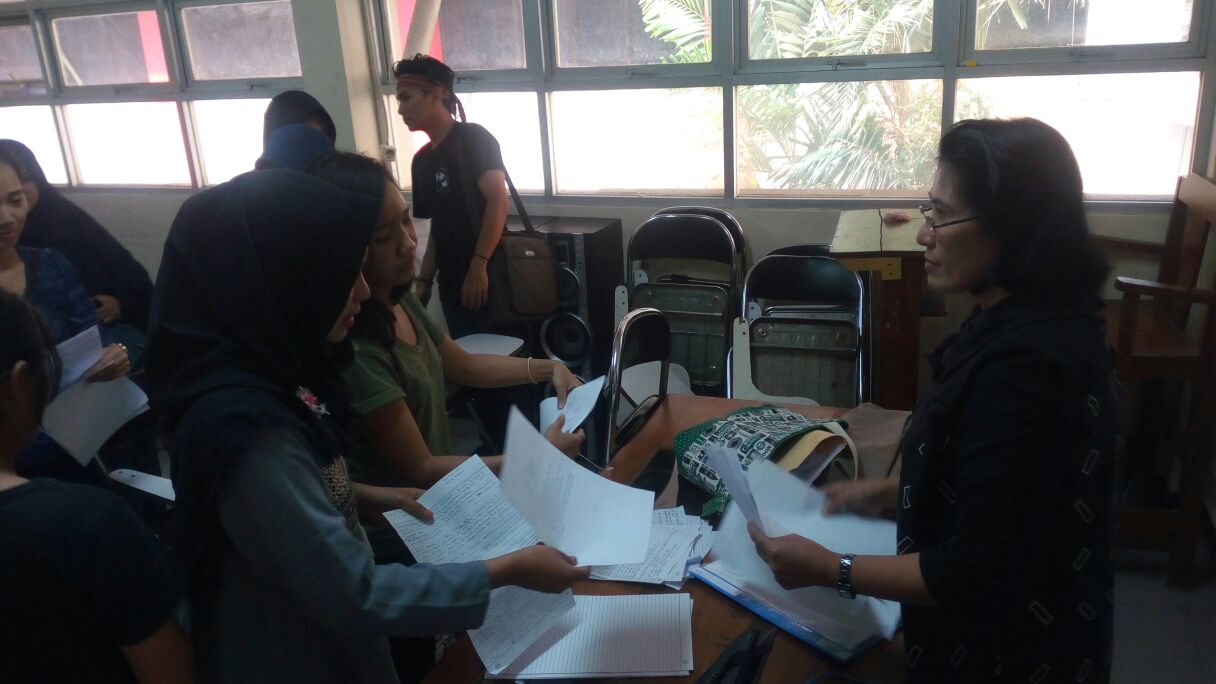JAKARTA, Indonesia — Hasnini Hasrah has been teaching at the State University of Jakarta (Universitas Negeri Jakarta, or UNJ) since 2003. The 43-year-old mother of three has spent years developing layered and adaptive curricula for all the classes she teaches in an ongoing quest to maximize students’ curiosity and learning.
Hasnini always comes to class punctually and prepared. She has a reputation for caring not just about students’ grades, but their development as compassionate, considerate communicators.
When she invited me to join her cross-cultural communication class for a discussion a few months ago, I eagerly accepted. The class got off to a good start, but about halfway through, Hasnini politely asked to be excused. To prove she was still present, she had to walk to a different building on campus and put her finger on a scanner between noon and 1:30 p.m. After she left the room, the students explained that their lecturer isn’t the only one to have to do that. Every morning, afternoon and evening, every UNJ educator, security guard and staff member must go to one of 15 machines on campus and place a finger on it. The routine is commonly (although for English speakers, somewhat paradoxically) referred to as “absen.” If they don’t absen, their salary is cut.
The practice has been proliferating for years as national funding has been used to install more fingerprint scanners, which cost around $60 apiece, in educational spaces throughout Indonesia. These machines and the rituals they enjoin raise a number of questions. What effect do they have on teacher absenteeism, morale and productivity? How does mechanization affect educators’ professionalism? In the case of UNJ specifically, was teacher absenteeism ever really a serious issue, or is this a solution in search of a problem?

To be clear, teacher absenteeism is generally a significant problem in Indonesia. A 2015 Organization for Economic Cooperation and Development (OECD) survey found that 13 percent of elementary and 16 percent of middle school classes were held without a teacher present.[1] I have witnessed the problem firsthand. Working at a vocational school in central Sulawesi in 2008, I was frustrated to find that some teachers who had attained coveted civil servant status came to school only a few times a year. Because their pay was guaranteed, they were able to routinely skip class, opting to provide private courses at home instead or open up businesses to augment their earnings.
But a decade later, the OECD data suggests fingerprint scanners haven’t mitigated teacher absenteeism.
I suspect a breakdown of that data would show the problem isn’t that all teachers are occasionally absent, but that a small core of corrupt civil servants is chronically absent. In that case, the OECD is irresponsibly casting all teachers in a bad light by presenting opaque aggregate data instead of pointing out bad apples in need of admonishment.
Punch the clock
Behind the problem lies another: firing civil servants is notoriously difficult in Indonesia. It happens so infrequently that when the minister of administrative and bureaucratic reform fired 31 at once in July—all for missing 46 days of work or more—it made national news.[2] To put a dent in teacher absenteeism, that would have to happen daily—and even such a drastic step wouldn’t guarantee a teacher would be present for every class session in the country because in addition to teacher absenteeism, teacher shortages also plague the nation.[3]
All that data and those anecdotes derive from elementary and secondary schools, not tertiary education. There is a surprising dearth of information available about educator absenteeism at Indonesian universities, and when I inquired with administrators at UNJ, I was informed that the data is kept by the assistant rector for administration, finance, infrastructure and personnel and not available to the public. Even the new rector has yet to see the data after two weeks working at the university—a point to which I will return shortly.
When I asked Hasnini about the extent to which educators neglect their teaching duties, her response made clear how complicated the issue is at the university level.
“I think it is common to miss class sometimes,” she told me. “Perhaps there is a seminar we would like to attend, or we need to be in the field for a week to perform research.” Indeed, university lecturers are held to different expectations than other civil servants because they must attend to the demands of the “tridharma”: teaching, research, and community service. “When we miss a class, we always hold a makeup session and turn in all of our attendance sheets… but professionalism can’t be measured strictly in terms of attendance.”
Hasnini, who has never struggled with chronic absenteeism, says she has no problem with the machines, saying they provide the easiest way to monitor absence. “Easy for whom?” I asked. “Well, for administrators, anyway,” she joked. But the joke appears to be on administrators because just down the road from the campus, I found several shops that will take a mold of your fingerprint and generate a plastic stamp that can trick the machines!
Her problem, and one I have heard voiced by lecturers from several UNJ faculties, is with the regulation that she must make three trips to the machine each day, and sometimes even miss class to be in compliance with the rule. It steals some 30 minutes from her every day.
Follow the Money
There is a difference between the use of the scanners at the university and other levels of school: a monetary incentive for professors to perform the silly ritual.
Just over two years ago, former rector Djaali (who, like many Indonesians, has only one name) introduced a new policy requiring all UNJ staff except him and his four assistants to absen three times daily. It allowed no grace period or allowable absence, and stipulated that a missed print resulted in the withholding of the incentive. Where the incentive went afterward wasn’t clear, however. Everyone I asked had no idea what happened with withheld funds, but all privately shared my suspicion that the money isn’t accounted for in the university’s annual budget. But what I found when I asked around is disturbing.
“It is impossible to say how much money was cut from teacher pay this year,”[4] said a source who spoke on condition of anonymity. “Let’s say, just for example, that the rector allotted $20,000 for fingerprinting incentives, and educators failed to absen 10 percent of the time. That $2,000 doesn’t go back into the budget—it becomes discretionary spending money, and the rector can allocate it as he wishes.” That’s commonly known as a slush fund.
The rector in question was relieved of duty earlier this month by the minister of higher education and research, although for a separate reason. (He allegedly coordinated the buying and selling of doctorate degrees and changed universities’ policies to allow plagiarism, a topic I may write about in a future newsletter.) Prior to his dismissal, I repeatedly requested an interview, but never received a response.
The current interim rector, Intan Ahmad, did agree to speak with me, and he had some good news for the UNJ community about the use of these machines: “I intend to [cancel that] policy as long as it doesn’t break any [governmental] rules, to boost the morale of the faculty. They aren’t factory workers,” he said. “But I will ask them to demonstrate their productivity with good teaching materials and publications, and I expect to see increased interaction with students.”
Although Intan contends that three times a day is not good policy, he doesn’t intend to remove the scanners and do away with fingerprinting entirely. When I asked if the machines still serve any purpose, he defended them to the extent that they “give us some data,” but acknowledged that they do not provide a valid measure of classroom teaching because, as he put it, “you can be present on campus and still not teaching.”
When I asked how mechanization is affecting the professionalism of educators, he replied bluntly: “we have to find ways to measure productivity other than by registering your fingerprint three times a day.”
Intan struck me as thoughtful and well-intentioned, but I was surprised by the importance he placed on measuring productivity and by his suggestion that we need to “find ways.” As most educators know, teaching is more of an art than a science, and much of what a good teacher does will forever elude quantification and measurement.
We don’t need to reinvent the wheel. As Hasnini recalled, the previous administration distributed surveys to students about absenteeism, educational quality and more,” then shared the results with all faculty members.
Neoliberal Logic
There is a logic that girds both the implementation of the scanners and the focus on measurable productivity that is built on false assumptions.
The first is well-known to anyone who has taught a large group of people: If you scold everyone to address the transgressions of just a few, you kill learning culture, diminish interpersonal trust and often end up encouraging the very behaviors you sought to eliminate. That 10 percent of elementary and secondary teachers are chronically absent from class is inexcusable, but disciplining the 90 percent who consistently attend does not solve the problem. I suspect both the OECD and UNJ made that mistake. In any case, neither has been transparent with their data.
Second, focusing on short-term problems such as teacher absenteeism in an attempt to increase productivity in the longer term builds on several presuppositions: that absenteeism is spread equally, as mentioned above, that increasing working time increases productivity, which has been repeatedly disproven,[5][6] and that schemes to increase attendance don’t generate problems that are even more difficult to measure, such as authoritarian management structures, graft and corruption on the part of those who oversee them.
Third, the notion that money is the best way to incentivize educators and schools to focus on improving hard numbers presumes that it is the primary motivator for educators and that withholding cash is the most effective way to bring about behavioral change. That presumption is not only insensible but insensitive. It treats educators like hourly wage earners whose salaries can be taken away and offered back as incentives, as opposed to professionals whose work is inherently complex. Reducing their work to ritualistic fingerprinting creates ironic and unfortunate situations like the one I witnessed while teaching with Hasnini, in which incognizant administrators force educators to engage in unprofessional behavior to prove their professionalism—relying on rituals that subtly undermine educators’ earned authority.

All three of these presumptions exemplify the sort of market-oriented, neoliberal logic increasingly being accepted as common sense in Indonesia and throughout the world. Although they may work well in business and industry, they shouldn’t be unquestioningly imposed on educational spaces. Schools at all levels bear responsibility for developing our critical faculties, inculcating us with a sense of duty to our nations and fellow citizens, and imbuing us with character traits such as honesty, humility, curiosity, compassion, empathy and more.
But when the factory model is applied to the university, degrees become salable products (sometimes leading to plagiarism scandals), and students and teachers tend to be treated like numbers.
Before I ended my conversation with Intan, the acting rector, I asked how he planned to address educational professionals who are chronically absent. His answer made clear that he sees danger in over-reliance on data and remains intent on treating educators as both people and professionals. “I would talk to them, find out why that did that kind of thing,” he said. “You don’t get the real situation with quantitative data, but by asking, you can know about their atmosphere, about the pressure they are under.”
Absenteeism creates problems and necessitates solutions, but there are other problems more worthy of our immediate attention. We should be wary of the extent to which market logic is changing our presumptions about the function of learning and on the possibilities we imagine for ourselves and future generations.
“Everything that can be counted does not necessarily count;
everything that counts can not necessarily be counted.”
~Albert Einstein
[1] https://www.cnnindonesia.com/nasional/20150325175500-20-41884/survei-oecd-guru-bolos-terbanyak-di-sumatera/
[2] https://nasional.tempo.co/read/889724/menteri-asman-abnur-pecat-31-pns-gara-gara-bolos-kerja-46-hari
[3] https://www.weforum.org/agenda/2015/12/where-are-the-worst-teacher-shortages/
[4] All translations are my own, and are as true to the speakers’ intentions as the languages allow.
[5] http://www.nytimes.com/2012/06/17/jobs/take-breaks-regularly-to-stay-on-schedule-workstation.html
[6] https://www.theatlantic.com/business/archive/2014/09/science-tells-you-how-many-minutes-should-you-take-a-break-for-work-17/380369/

